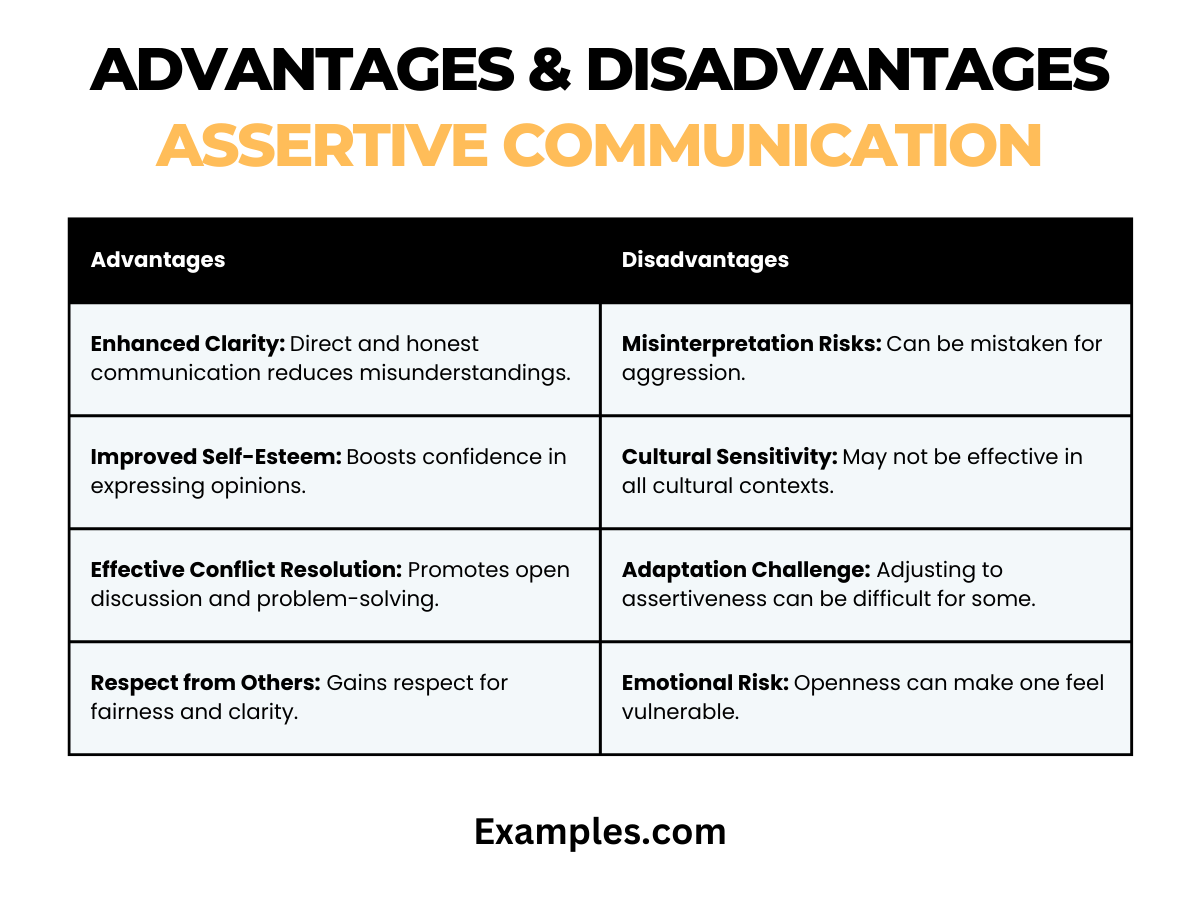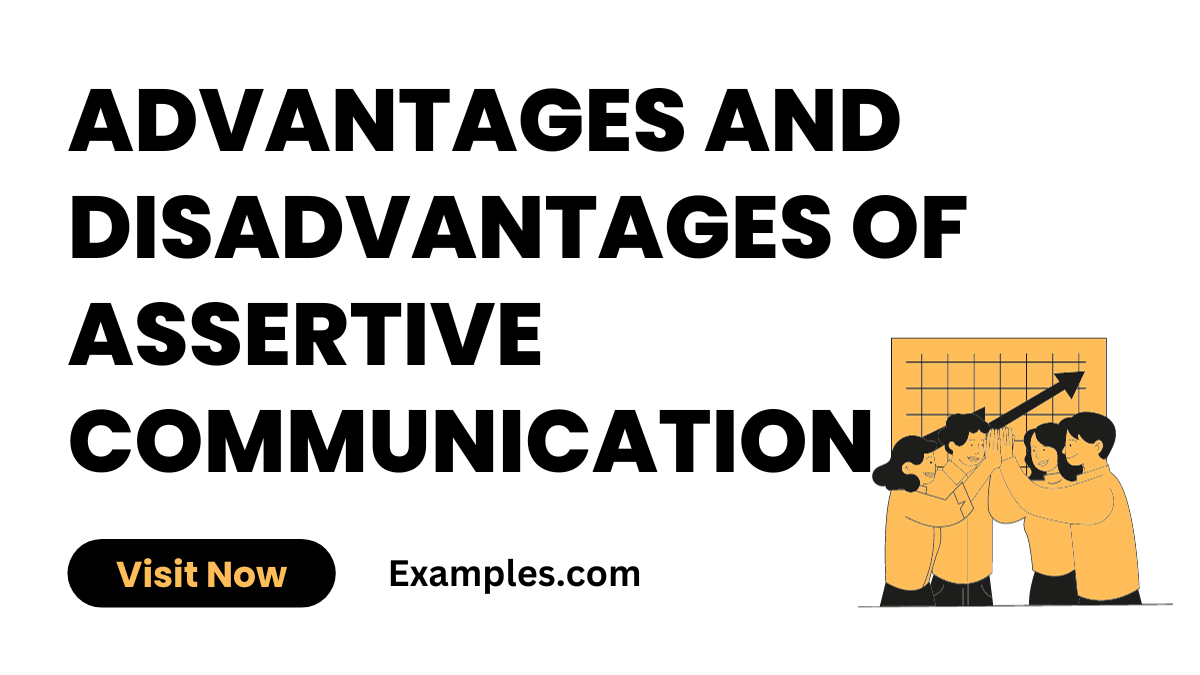Advantages and Disadvantages of Assertive Communication
Embark on a journey to explore the Advantages and Disadvantages of Assertive Communication with our comprehensive guide. This guide offers insightful Communication Examples to illustrate the impact of assertiveness in various scenarios. Learn how assertive communication can enhance relationships and workplace interactions, along with the challenges it might present. Whether you’re looking to boost your personal communication skills or aiming for professional growth, this guide provides a balanced view to help you navigate the complexities of assertive communication effectively.
What are the Advantages and Disadvantages of Oral Communication?
Delve into the world of communication with our enlightening guide on the Advantages and Disadvantages of Assertive Communication. This comprehensive overview not only defines assertiveness but also traces its origins and history, offering practical examples and tips. Learn how assertive communication can be beneficial in creating clear and respectful interactions, and understand the potential challenges it may present. Whether you’re seeking to improve personal dialogues or enhance workplace communication, this guide is an invaluable resource for mastering the art of assertiveness in various aspects of life.
Advantages and Disadvantages of Assertive Communication

| Advantages of Assertive Communication | Disadvantages of Assertive Communication |
|---|---|
| Enhances Self-Esteem: Being assertive helps individuals feel confident in expressing their views, leading to improved self-esteem. | Misinterpretation: Sometimes, assertiveness can be mistaken for aggression, leading to misunderstandings. |
| Clear Communication: Assertiveness allows for direct and honest expression, minimizing misunderstandings. | Difficulty in Adaptation: For those accustomed to passive or aggressive styles, adjusting to assertiveness can be challenging. |
| Respect from Others: Assertive individuals are often respected for their clarity and fairness in communication. | Cultural Sensitivity: Assertiveness may not be equally effective or appropriate in all cultural contexts. |
| Effective Conflict Resolution: Assertiveness promotes open discussion and problem-solving, leading to effective conflict resolution. | Emotional Risk: Being open and honest about feelings and needs can make one feel vulnerable. |
| Improved Relationships: Assertive communication fosters mutual respect and understanding, enhancing personal and professional relationships. | Overuse: Excessive assertiveness can sometimes be off-putting or intimidating to others. |
| Empowers Decision-Making: Assertive communication encourages active participation and contribution in decision-making processes. | Contextual Limitations: In certain situations, like hierarchical workplace structures, assertiveness may not always be welcomed. |
| Promotes Honesty and Openness: It fosters an environment where individuals can express themselves truthfully and openly. | Potential Conflict: Being assertive can sometimes lead to initial disagreements or confrontations. |
| Encourages Mutual Respect: Assertiveness is based on respect for oneself and for others. | Skill Development Required: Developing assertive communication skills requires time and effort, which can be a barrier for some. |
Advantages and Disadvantages of Assertive Communication Essay
Assertive communication, a key to effective interpersonal interactions, offers numerous benefits and challenges. This essay delves into how assertiveness enhances clarity in communication, fosters respect, and empowers individuals in their personal and professional lives. However, it also examines the potential drawbacks, including the risk of being misinterpreted as aggressive and the challenges of cultural sensitivity. The essay aims to provide a nuanced understanding of how assertive communication operates within various contexts and its impact on relationships.
Advantages of Assertive Communication
- Fostering Open Dialogue: “Let’s discuss this openly to understand each other better.” Encourages honest and open conversation.
- Enhancing Team Collaboration: “I value everyone’s input; let’s collaborate to find the best solution.” Promotes teamwork and inclusivity.
- Building Professional Relationships: “I appreciate your expertise in this area.” Acknowledges and respects colleagues’ skills.
- Assertive Sales Approach: “Our product offers these unique benefits…” Confidently presents product advantages.
- Handling Customer Complaints: “I understand your concern; let’s find a solution.” Addresses customer issues effectively.
- Expressing Personal Needs: “I need some time off to recharge and return more productive.” Assertively communicates personal needs.
- Advocating in Negotiations: “I believe this deal can be beneficial for both of us.” Advocates for win-win situations.
- Maintaining Personal Boundaries: “I’m not comfortable with this; let’s find an alternative.” Clearly sets personal limits.
- Positive Parenting Communication: “I understand your viewpoint, but these are the rules.” Balances understanding with firmness.
- Leadership Decision Making: “Based on the data, my decision is…” Demonstrates assertive and informed leadership.
Disadvantages of Assertive Communication Essay
- Potential for Conflict in Sensitive Situations: “I insist we address this issue now.” Assertiveness in delicate situations can sometimes escalate conflict.
- Being Perceived as Rude or Insensitive: “I don’t agree with your idea.” Directness may be misconstrued as rudeness.
- Overstepping in Group Dynamics: “I think we should follow my plan.” Assertiveness might dominate group opinions.
- Resistance in Traditional Hierarchies: “I believe a different approach is better.” Assertiveness may clash with established norms.
- Misinterpretation Across Cultures: “Let’s change this procedure.” Directness might be offensive in some cultures.
- Strain on Personal Relationships: “I need you to change this behavior.” Assertiveness might strain close relationships.
- Difficulty in Transitioning Styles: “I’m not used to speaking up.” Shifting to assertiveness can be uncomfortable.
- Risk of Isolation: “I prefer to work independently on this.” Assertiveness might lead to social isolation.
- Stress from Continuous Self-Advocacy: “I need to constantly assert my needs.” Continuous self-advocacy can be exhausting.
- Challenge in Balancing Assertiveness and Empathy: “I’m right in this situation.” Balancing assertiveness with empathy can be difficult.
Advantages and Disadvantages of Assertive and Non-Assertive Communication
| Assertive Communication | Non-Assertive Communication |
|---|---|
| Advantages: | Advantages: |
| – Promotes clear and direct expression. | – May avoid conflict in the short term. |
| – Enhances self-esteem and confidence. | – Can be less emotionally demanding. |
| – Leads to effective conflict resolution. | – Passive style may be preferred in certain cultural contexts. |
| – Builds respect and trust in relationships. | – Aggressive style may yield immediate results in some scenarios. |
| – Encourages honest and open dialogue. | |
| Disadvantages: | Disadvantages: |
| – Can be perceived as aggressive if not balanced. | – Passive style often leads to unmet needs and resentment. |
| – Requires emotional intelligence and control. | – Aggressive style can damage relationships and create hostility. |
| – May not be effective in all cultural contexts. | – Passive style can lead to a lack of assertiveness and loss of voice. |
| – Challenging to adopt for those used to passive or aggressive styles. | – Aggressive style can result in long-term negative consequences. |
| – Risk of being misinterpreted in sensitive situations. | – Both styles may lead to poor communication and misunderstanding. |
This table provides a comprehensive comparison of the advantages and disadvantages of assertive versus non-assertive communication styles. It highlights how each approach impacts interpersonal interactions and the potential outcomes of adopting these different communication methods.
In conclusion, assertive communication offers a myriad of benefits, such as enhanced self-esteem, clear and honest expression, and effective conflict resolution, while also presenting challenges like the risk of misinterpretation, difficulty in adaptation, and cultural sensitivity. To further explore the advantages and navigate the challenges of assertive communication, consider these two external resources:
- American Psychological Association (APA) Article: The APA provides in-depth insights into the benefits of assertive communication. Their resource is particularly useful for understanding the psychological aspects and the impact of assertiveness on personal and professional relationships. You can access this valuable resource at APA’s Article on Assertive Communication.
- Psychology Today Article: This article discusses situations where assertive communication may not be the best approach. Understanding these scenarios can help individuals adapt their communication strategies effectively across different contexts. The article is available at Psychology Today on When Not to Be Assertive.
These resources, sourced from high-authority websites, offer a comprehensive view of assertive communication, providing valuable insights for those seeking to enhance their communication skills while being aware of its limitations and challenges.



